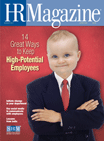
Business leaders who use the 9-box grid need to decide whether to tell employees where they stand on the grid. “Employees are pretty curious to know about the succession management process,” says Barb Arth, a senior analyst at Bersin and Associates, a talent consultancy in Oakland, Calif. But “There’s a difference between being transparent about the process and the names on the plan.” She advocates being completely clear about how the process works. However, she advises organizations to be cautious about widely revealing the names of who is in each box on the matrix.
Arth says it is beneficial in the long run for each individual to know his or her status. “Our research shows that increased transparency is better, though there is a short-term downside in the form of attrition or dissatisfaction for some valuable employees who have not been identified as top talent,” she explains. However, increased transparency allows those who may not be advancing to understand why. This knowledge is critical for performance improvement. “Many companies fear creating an elitist mentality, but we have found if it is handled with tact and grace, it enhances the process,” she says.
Executives at Whirlpool Corp. conclude that transparency is the best approach. “We believe all employees in our company should know where they stand in the 9-box,” says Tim Reynolds, vice president of talent and organizational effectiveness for the home appliance manufacturer headquartered in Benton Harbor, Mich. “We are more concerned they are getting the right message about how they’re viewed and where they could improve.”
Michelle Biro, director of talent management for Whirlpool, concedes that it took a number of years before managers felt “100 percent comfortable” conveying the information to employees. It’s important to continually emphasize in the conversation that this is the assessment at this point in time. It can change,” she notes.
Arth agrees: “HR needs to communicate that this is the status they are today. It isn’t a title they retain forever. They could fall off that status if they don’t continue outperforming their level, or they may make changes to improve performance.”
The author, a former HR generalist and trainer, is a freelance writer in Wixom, Mich.
Advertisement
An organization run by AI is not a futuristic concept. Such technology is already a part of many workplaces and will continue to shape the labor market and HR. Here's how employers and employees can successfully manage generative AI and other AI-powered systems.
Advertisement


